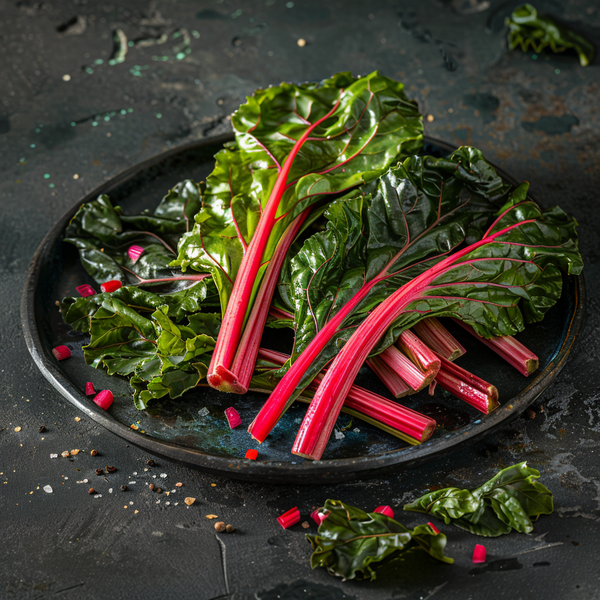
Swiss Chard
Swiss chard is a leafy green vegetable known for its bright, colorful stems—ranging from white to yellow to red—and its large, dark green leaves. It has a slightly bitter taste that mellows when cooked, making it versatile for a wide array of culinary applications. Here’s how Swiss chard is commonly used in cooking:
Sautéed: One of the most common ways to prepare Swiss chard is by sautéing it with garlic and olive oil. It can be seasoned simply with salt and pepper, or enhanced with red pepper flakes, lemon juice, or vinegar to balance its bitterness.
Soups and Stews: Swiss chard can be added to soups and stews, contributing nutrients, color, and a mild, earthy flavor. It pairs well with beans, lentils, and a variety of meats.
Quiches and Frittatas: Chopped Swiss chard is a great addition to egg dishes like quiches and frittatas, adding color, texture, and a touch of bitterness that complements the creamy eggs.
Stir-Fries: Swiss chard can be used in stir-fries, cooking quickly and adding a nutritious component alongside other vegetables, meats, and sauces.
Stuffed Chard Leaves: Similar to cabbage rolls, Swiss chard leaves can be blanched to soften them and then used as wrappers for a filling made from grains, meats, and spices, baked in a savory sauce.
Pasta Dishes: Chopped Swiss chard can be incorporated into pasta dishes, either as part of the sauce or as a vegetable addition, where it pairs well with both light and creamy sauces.
Gratins: Swiss chard can be layered with potatoes, cheese, and béchamel sauce to make gratins—a baked dish that highlights the chard’s flavor while mellowing its bitterness.
Salads: Young, tender Swiss chard leaves can be used raw in salads. They have a milder flavor than the mature leaves and can be mixed with other salad greens, nuts, fruits, and a vinaigrette dressing.
Side Dishes: Braised Swiss chard, cooked slowly with a bit of broth, garlic, and seasonings, makes for a flavorful side dish that complements a wide range of main courses.
Smoothies: For a nutritional boost, raw Swiss chard leaves can be added to smoothies. They're best combined with sweet fruits to balance the chard’s slight bitterness.
Swiss chard stems are edible and can be cooked along with the leaves, although they may require a longer cooking time due to their firmer texture. Adding a bit of acidity (like lemon juice or vinegar) at the end of cooking can help neutralize the bitterness of the leaves and enhance their flavor. Swiss chard is not only versatile in the kitchen but also offers a wealth of nutrients, including vitamins A, C, and K, making it a healthful addition to a variety of dishes.
Nutritional Information
calories
19
carbohydrates
3.74 g
fats
0.2 g
protein
1.8 g